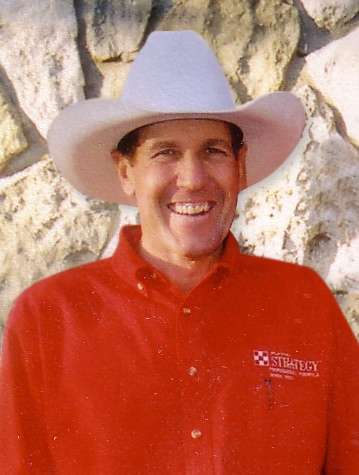“There’s sure been a lot of change, but the Flint Hills have stayed the same.”
Not horseback nowadays, Gene Barr still lives in the Barr Ranch home where he was born in 1926.
“These native grasslands are still the best grassland in the world for efficient gains on grazing cattle,” Gene insisted.
Eyesight dimmed and hearing some shy, Gene’s almost 96-year-old memory is near perfect reflecting from his living room chair.
“There’s nothing like getting up before sunrise, riding your horse to the train station and driving cattle to pasture,” Gene declared.
In Morris County on the Chase County line, the Barr Ranch is along Diamond Creek with rich farmland below the grasslands. Close-by is remains of the now-long-begone but not forgotten never-too-big Diamond Springs community only identified by a modern-day sign.
“We usually say we’re from Diamond Springs, but our address now is actually Burdick,” the real cowboy smiled. “Hymer is just up the trail. All three of the communities were cow towns with railroad stockyards at the turn of the last century.”
Frank Barr, Gene’s grandpa, bought the original 80-acres of the now five-generation Barr Ranch in 1879. “The government gave land to the railroad so they could build tracks for trains shipping cattle,” Gene said.
Actually, the Barr family is second owner of their property purchasing it from the one who bought the railroad land. “Grandpa bought the place for $2.50 an acre, which was a lot of money in those days. I’m sure glad he did,” Gene said.
Carl Barr, Gene’s dad, expanded landholdings, as did Gene, and now Gene’s son Ben is working manager of the ranch. “My son (teenager) Samuel says he’s ‘going to the school-of-hard-knocks’ learning about ranching to continue the next generations,” Ben smiled.
An important asset to Barr Ranch operations is Ben’s wife Rachael, a medical doctor who has served the area. “I’m a fulltime rancher’s wife now, which actually does keep me busy, and I really enjoy it,” Rachael said.
Gene’s wife Nita passed away in November 2020, after the couple had been married 67 years.
“Nita kept us all in line,” Gene admitted. “Her family moved to Hymer where her dad Ben Hamilton managed the large Robbins Ranch. Nita had a strong affection to support ranch life for raising our family which also includes two daughters, Kathy and Mary.”
Quite diverse, Nita was artistically talented, but perhaps as widely known for her culinary skills.
“Mom was a great cook and had several off-the-ranch employments working as a cook,” Ben inserted. “Our neighbors wanted to trade work with Dad because they knew Mom was such a good cook. She’d always invite them for dinner, of course fried chicken, mashed potatoes, and homemade pie.”
Ben was named after his grandpa Ben Hamilton. “I have Flint Hills ranching in my genes from all sides that’s for sure,” Ben (Barr) appreciated. “There’s a lot of family tradition to hold up and continue, but I enjoy it and do my best.”
Eyes brighten as Gene reflected on heydays when trainloads of cattle from Texas shipped into area stockyards.
“Trains arrived at all hours it seemed, but we had to be there when the steers were unloaded,” Gene said. “There weren’t any trucks, so we rode our horses there, and then drove the cattle to big pastures.”
Sometimes, the 4,000-to-6,000 acres summer pastures were 10 miles across Flint Hills from the depot.
“Those spotted longhorn Mexican steers were at least three years old, some older, yet only weighed 600-to-700 pounds,” Gene said. “Trains had as many as 48 cattle boxcars, each one holding about 30 steers.”
Native pastures, owned by non-tenant, distant landowners, were annually burned for controlling invaders while improving grass nutrition.
“I really never met many of either the landowners or the cattle owners,” Gene noted. “We handled business by honest word-of-mouth, and it generally always worked out well.”
With rapid gain on the lush Flint Hills, cattle weighing about 900 pounds would start being shipped in late July.
“We’d round up a pasture and sort off some of the bigger end,” Gene said. “We’d drive them to Diamond Springs, Hymer or Burdick to load on the train to the terminal packing house in Kansas City. I remember a time they’d bring about 2-1/2 cents a pound off grass.”
Weekly through end of summer, remainder of the steers were rounded up for train shipment to the terminal.
“When I was a kid, Dad had a fellow come teach me how to trick rope,” Gene said.
Taking to the artistic skill readily, Gene did local trick roping shows and also performed certain stunts horseback. Interesting that it was a talent continued for a lifetime.
A few years ago, Gene’s daughter Kathy accompanied him to the Wichita Zoo for a Pioneer Days event. He demonstrated trick roping and even roped his daughter proving his diverse abilities.
Daughter-in-law Rachael noted that when 81-years-old, naturally right-handed Gene taught himself to do rope tricks left-handed. Rachael took a photograph of Gene left-handed roping his then four-year-old grandson Samuel.
“Their combined ages was 85,” Rachael noted. “That an 81-year-old could rope a toddler on the trot was impressive. But for a “righty” to do it left-handed was a feat to remember.”
Cowboy was his profession with abilities best proven in rodeo competition, yet Gene talks little about that. “Dad sure never brags about his rodeo career,” Ben inserted. “I have heard others talk about him and seen some pictures, but Dad lets on like it wasn’t much.”
Gene’s older brother Jim, prominent Cottonwood Falls rancher-auctioneer-former rodeo announcer, was more widely recognized as a winning rodeo bull rider. “I got on some, but Jim was the rodeo cowboy,” Gene underrated himself.
Photos reveal Gene’s abilities in rough stock events and calf roping. Ben cherished a fact his Uncle Jim shared with him. “Jim said Dad rode eight bucking bulls at the Roberts rodeo arena in Strong City without getting bucked off,” Ben related.
Further proof of Gene’s rodeo arena skills came during his U.S. Army service when stationed in Battle Creek, Michigan. He borrowed a cowgirl’s horse and placed first in calf roping.
While reminiscing that day, Ben heard for the first time that Gene also won steer riding at the rodeo.
Questioned if that made him the all-around champion, Gene admitted, “I guess it would have, but they didn’t do that then.”
Rodeos were even hosted on the Barr Ranch in 1945 and 1946. Gene had the opportunity to enjoy the fun when he was home on Army furlough one of those years.
Ranchers often become a bit snide when sheep are brought into rangeland. But a young Gene tried that agricultural enterprise, although it didn’t last long.
“I don’t think Dad was too high on the idea, and we never made much,” Gene admitted. “It was an ordeal shearing the sheep that’s for sure, but I’m glad I tried the business.”
Of course, there weren’t many tractors during Gene’s early youth. “We worked horses,” he said. “We had several good teams; one big horse was worked with a mule. I did lots of hay raking with the teams.”
All hay was mowed, raked, and stacked with horsepower and manpower. “Later on, Dad had half interest in a stationary baler, but that was lots of work, too,” Gene said. “You had to pitch the hay into the baler, then wait until the wire tied, before moving on.”
The family did get a Farmall tractor to ease farming work in the late 1920s. “We had good bottomland and could raise good grain crops, but I enjoyed the cowboy work more,” Gene admitted.
All livestock has always been close to Gene’s heart. “I had a lot of different wild animals, raccoon, rabbit, coyote, growing up,” he said. “I had a tame crow recently. It was brought to me injured, I fed it up, and it stayed for more than a year.
“The crow would ‘caw’ to me in its own unique way, and even eat out of my hand,” Gene said. “It would walk behind when I went to get the mail. The crow would fly at the dog and cats to make known it was the top honcho.
“Finally, he, or maybe it was a she, ventured off,” Gene continued. “But I think that crow comes back sometimes, although the mates don’t want it in the ranch yard.”
Ranch operations today are limited to a cow herd and crop farming. “We started out with Hereford cows. One cow my mom was really fond of cost $27.50,” Gene said. “We’ve used different bulls through the years, and now the herd is all black or black whiteface. Angus bulls generally mate the cows although we will buy a Hereford sometimes.”
Today confined more than he likes, Gene mows the ranch lawn, takes care of his pets and knows everything that goes on. “I want to do more, but my age holds me back,” he admitted.
“I had both knees replaced several years ago and got back on a horse in a few days,” Gene said. “I have shoulder aches and wanted to have surgery, but the doctor wouldn’t do it. I wish he would have.”
Some of the family does spend the night at Gene’s house, although he’s in good health. “I’m glad to have my own personal doctor Rachael around in case I ever have an issue,” Gene appreciated.
“Gene doesn’t drive anymore,” Rachael noted. “But he’ll go me, Sam, or his daughters around the ranch when we are helping Ben and offers appreciated advice. He knows and remembers everything about the ranch.
“Gene and Ben can always communicate with few words or even without a word,” Rachael added.
“Gene is known for his modesty, honesty and good memory,” Rachael pointed out. “But he enjoys tall tales and yarns as any real cowboy would.”
Looking ahead, Gene said, “There have been lots of changes in my lifetime. The way things, land, fuel, everything has gone up, it concerns me about the future.
“I’ve had a blessed life and so fortunate my family will continue operating this ranch. That gives me a certain peace,” the real cowboy Gene Barr declared.
CUTLINES
Gene Barr, 96, enjoys reflecting and relating stories as a lifetime cowboy on his family ranch near Diamond Springs in Morris County. (Pioneer Bluffs photo)
The Barr Ranch at Diamond Springs, started in 1879, is now operated by Gene Barr, his son Ben, grandson Samuel and daughter-in-law Rachael.
Gene Barr and son Ben Barr manage the Barr Ranch which has been in the family since 1879. (Barr family photo)
Championship bull riding proved Gene Barr’s real cowboy ability at amateur competitions throughout the area. (Barr family photo)
Trick roping skills were learned by Gene Barr at an early age. He performed at local events also doing trick riding. (Barr family photo)
Speckled longhorn Mexican steers were shipped from Texas to the railroad stockyards at Diamond Springs, Kansas. (Barr family photo)
Three-year-old steers weighing 600 pounds were shipped to the Flint Hills for summer grazing. (Barr family photo)
Flints Hills are known worldwide for efficient gains on summer grazing cattle such as these longhorns in the 1930s. (Barr family photo)
Gene Barr and family members accepted an award from the Morris County Soil Conservation Service for lifelong conservation efforts on the Barr Ranch near Diamond Springs. (Courtesy photo)
When he was 81 years old, naturally right-handed Gene taught himself to do rope tricks left-handed. His daughter-in-law Rachael Barr took a photograph of Gene left-handed roping his then four-year-old grandson Samuel. (Barr family photo)





